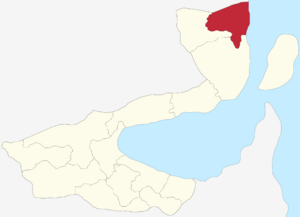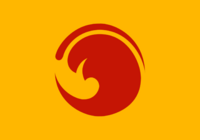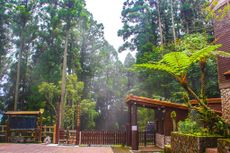Luhai (state)
Luhai 綠海州 Lǜhǎi zhōu | |
|---|---|
 Map of Monsilva with Luhai highlighted | |
| Country | |
| State status | 1 July 1984 |
| Capital | Luhai (綠海) |
| Government | |
| • Body | Luhai State Government |
| • State Minister | Liang Ming (Liberal) |
| • Deputy State Minister | Xu Yating (Liberal) |
| Population (July 2022) | |
| • Total | 6,094,770 |
| Time zone | AMT-12 (Monsilvan Standard Time, MST) |
| ISO 3166 code | MS-LUH |
| GRP (M¥) | M¥1.26 trillion |
| Major airports | Luhai Qingdao International Airport (LQO) Tsingyi City Airport (TCA) |
| Transit System(s) | MRA Federal North Railway Luhai Metro |
| Police[1] | Luhai State Police |
| Ambulance[2] | Luhai State Ambulance |
| Fire[3] | Luhai Fire Service |
Luhai (Monsilvan: 綠海州; Pinyin: Lǜhǎi zhōu), is a state of the Monsilvan Republic. The state has around 6.1 million people, with 71% of them living in the state's capital of the same name, Luhai City. It is located in northern Monsilva, sitting north of Meixian, east of Leibo and south of the nation of Fujikuni. Luhai has a moderately warm climate, especially near the coast. Luhai is also one of Monsilva's most earthquake prone states. The state of Luhai is governed by the Luhai State Government, with Liang Ming of the Liberal Party being the current state minister. The state is divided into 9 districts, 31 counties and 77 municipalities and is equally represented by 9 Senators in the Senate and 31 members in the Legislative Assembly. The Luhai State Parliament consists of 77 seats, and is currently lead by the Liberal Party, with the FDP leading the opposition.
Luhai is Monsilva's second most populous state, and has the second highest urbanization of all the states, being overtaken by Amking which is in first for both. In terms of industry, rural Luhai produces basic agricultural products such as wheat. However, most of Luhai's industry takes place in the cities. Luhai City has a massive amount of industries, ranging from technology to medical to logistics. Tsingyi is Luhai's only city other than the capital and has a population of just over 1.5 million people. Tsingyi is located to the west of Luhai City and is often considered a part of Luhai City's greater metropolitan area, especially since it is served by the Luhai Metro. Luhai has a nominal GRP of around ₵208 billion, giving it a GRP per capita of ₵34,193.
Luhai is connected by the Monsilvan Railways Administration and the Federal North Railway which connects towns and cities in Luhai to the rest of Monsilva. Luhai, as well as having the MRA and FNR, is also served by the Luhai Metro which not only serves Luhai City, but also Tsingyi and some surrounding areas. Luhai has two international airports: Luhai Qingdao International Airport and Tsingyi City Airport. The Monsilvan high-speed rail service terminates at Luhai City, and runs to cities such as Amking, Waiping, Menchi and Maojie.
Contents
Toponymy
The name, Luhai comes directly from the HY Pinyin of the Monsilvan "綠海". The character "綠" means "green" in Monsilvan, and the character "海" means "sea". Luhai directly translates to "green sea", which most likely originated due to the large amount of algae which can be found near the Port of Luhai making the sea appear green.
History
Prehistory and early dynasties
Luhai has been inhabited for thousands of years, and the area where the city is now has been a settlement since the 10th century BCE. During the Qin dynasty, which lasted from 792 BCE to 1201 CE, Luhai City was the capital of the dynasty throughout its history. This has lead to Luhai having many important historical buildings scattered around. However, most of the buildings still standing from this period can only be found outside of the city limits, as many buildings were demolished during the Zhou dynasty.
Luhai became a very busy region thanks to many people coming from other regions to the Port, which was built in the early 9th century CE. This made Luhai's population grow massively over the years and made it one of the richest regions in Monsilva.
Zhou dynasty and the Empire of Baltanla
When the Unification of the Monsilvan Kingdoms took place in 1201, Luhai lots its capital status, and the government of the Qin dynasty was disbanded. This lowered the regions status in politics, and effected its economy. However, the importance of the Port of Luhai meant that it quickly recovered and the region began to grow exponentially in population.
By the late 14th century, Luhai was Monsilva's richest region and housed many domestic and foreign merchants, many of whom were more politically important than the Emperor himself. However, during the decline of the Zhou dynasty, many merchants left the Luhai region, and its economy began to decline along with the rest of the dynasty. Thanks to Luhai's accumulated wealth, most of the region dealt moderately well with the decline.
When the Zhou dynasty voluntarily ceded itself to the Empire of Baltanla in 1500, the region was hopeful that new Baltanian merchants would come to Luhai and regrow its economy. Fortunately for the region, their wishes came true and by the end of the 16th century, Luhai had returned to its position of being Monsilva's richest region.
Kingdom of Great Shan and the Civil War
When Monsilva left the empire in 1730, Luhai was in much better shape than how it had entered. It had become a vital part of the country, and had become a region full of many different people from all across Terraconserva. Luhai continued to grow throughout the existence of the Kingdom of Great Shan, both in population and economically.
When the Monsilvan Civil War arrived in 1824, Luhai was the capital of the Liberate Monsilva Movement, and so it is where the most important people of the movement were based. This lead to frequent naval bombardment by the imperial government during the war, which caused major damage to the City of Luhai, especially the port and important waterfront buildings. After the war ended in 1830, the city required a large amount of repairs, which were acted on fairly rapidly due to the major importance of the Port and the city to the entire country's economy.
Kingdom of Monsilva and the Republic
During the Kingdom of Monsilva, Luhai retained its position as the second most important region in the entire country, and it became the home of the Monsilvan Navy. The cities of Luhai and Tsingyi also began growing rapidly and quickly became home to many new domestic industries such as Fushao, as well as many international companies.
During Martial law in Monsilva, Luhai was constantly filled with police. This was due to the frequent rioting that took place in the city against the government. This got worse in the 1978 Monsilvan protests, where Luhai alongside other major cities in Monsilva began a unanimous protest and general strike. This lasted from March 1978 all the way until the government formally resigned on 25 December 1978. During these protests, both Luhai and Tsingyi suffered a lot of structural damage in busy areas. However, thanks to the large volunteer movement by the Monsilvan Revolutionary Army, this damage was repaired by the end of April 1979.
The state was not established immediately after the Monsilvan Republic was established, and instead, Luhai was a part of the state of Leibo. Until 1984, when the state of Luhai was created and granted autonomy. This lead to the creation of the Luhai State Government, which was lead by the FDP from its establishment until the 2002 local elections, where it was overtaken by the Liberal Party, which has lead the state government since then.
Administration
Local government
The state of Luhai is governed by the Luhai State Government, based in the Luhai State Office in Luhai City. The state government is a unicameral legislature consisting of a 77-seat State Parliament. Each municipality in Luhai is represented by one State Parliament Member. Members are elected for for two-year terms. The Parliament meets every week, with the day depending on the first weekday after the State Parliament elections which take place simultaneously across Monsilva every two years. The leading party in the State Parliament determines who will be the State Minister. Liang Ming of the Liberal Party has been the Luhai State Minister since 2016.
National government
Luhai is represented in the Parliament of Monsilva by 9 Senators in the Senate of Monsilva and 31 Members of the Legislative Assembly. As of the 2020 federal election, Luhai is represented in the Legislative Assembly by 17 RNP members, 9 FDP members and 5 Liberal Party members. Luhai is represented by 4 RNP senators and 3 Liberal senators and 2 FDP senators since the 2020 senate election.
Geography
Luhai is quite flat along its coast and in the north, while it gets more hilly the closer it gets to Leibo. Luhai has frequent rainfall and suffers from earthquakes, however the architecture in the state is well prepared for them, including the EEWS. The Chun River flows through the state, with the mouth at the Port of Luhai in Luhai City.
Luhai has many beaches along the coast that are popular during the summer months, whilst in the winter, most tourists will visit national parks in the state's western region, where the landscape is full of forests, many of which are untouched.
Climate
Luhai is generally quite warm all year round, temperatures usually don't go below 5 degrees celcius and can reach peaks of 33 in the summer months. However, Luhai does suffer from lots of rainfall during the wet season, which has occasionally caused minor floods in coastal regions, and regions near the Chun River. In the autumn and spring, the climate is very temperate and the air is usually less humid. Snow has been known to fall in the state, although this hasn't happened in a significant way since 1986.
Demography
| Country of Birth | Population | Percent | |
|---|---|---|---|
| 5,263,443 | 86.36 | ||
| Non-Monsilvan | 831,327 | 13.64 | |
| 23x15px Fujikuni | 676,519 | 11.1 | |
| 79,232 | 1.30 | ||
| Others | 75,575 | 1.24 | |
| Total | 6,094,770 | 100.0 | |
The 2022 census recorded that 831,327 people or 13.64% of Luhai's population were foreign-born. The table to the right shows the most common countries of birth of Luhai residents. Luhai is a very urban state, which is likely why it has such a large number of migrants. 96% of Luhai's population live in cities, being either Luhai City or Tsingyi, which is also where the vast majority of Luhai's foreign-born population lives. The other 243,791 people living outside of the cities are predominantly Monsilvan and live in towns scattered across Luhai's southern farmland regions.
Religion
Luhai is Monsilva's most secular state, with 51.3% of the population putting 'Unaffiliated' for religion on the 2022 census. This has been the case for many years, and it is likely due to the secular nature of Fujikuni and many of its people who live in the state.
Following the 'Unaffiliated' category in the census was Monsilvan folk religion at 38.7%; then it was Buddhism at 6.0%; and finally 'Other' (which includes Christianity and Islam) took up the last 4.0%.
Transport
Luhai's transport is administered by the state's Department for Transport, which is a sub-department of the federal Department of Transport. Luhai is one of Monsilva's most accessible states by rail transport, with 18 railway stations that are served by the MRA, as well as being well serviced by the Federal North Railway and having an extensive metro network. In terms of public road transport, bus and coach services run across the state, and connect to other locations around the country.
Thanks to the accessibility of public transport in Luhai, many "green changes" have been made to the state. "Green changes" is a term coined by Luhai State Minister Liang Ming to refer to the phasing out of large road networks in favour of eco-friendly rail or electric bus travel. This has happened a lot in central Luhai City, which has almost entirely become pedestrian only.
Education

Education is mandatory until the age of 18 for children living in Luhai, which is two years above the minimum age at the federal level (16). Luhai's towns and cities feature many schools, from elementary to high school. As well as this, Luhai is home to many higher education institutes including:
- University of Luhai
- Tsingyi University
- Linluo Science and Technology University
- Jilong University
- Luhai State University, Kanding
The University of Luhai (UOL) is a highly regarded university, which specialises in most subjects and has alumni which have ended up in major political or social roles. For example, Xu Zhou-da, the first president of Monsilva as well as current president Chiu Zan were students at UOL. Other alumni include Liang Ming, the current Luhai State Minister, as well as all previous state ministers of Luhai. UOL is also home to one of only two nuclear fusion reactors in Monsilva. UOL is generally regarded as Monsilva's second most prestigious university, following behind Central Amking University.
Tsingyi University (TYU) is a well regarded university. It has the nickname "綠京落選者大學", which can be roughly translated from Monsilvan to mean "University of Luhai and Amking rejects", this nickname is thanks to the large number of students that have applied to either the University of Luhai or Central Amking University, and have been rejected that end up studying at TYU instead. However, TYU is one of Monsilva's best universities and has won many awards for its high student satisfaction.
Culture
Tourism
Luhai is a massive tourist destination, usually coming second in number of tourists after Amking. Most tourists visit Luhai City, as it has plenty of tourist attractions and events that take place almost every day in different parts of the city. Popular tourist attractions include Kaohsiung Tower, the Museum of the Natural World, Luhai National Football Stadium and the Miniatures Museum of Monsilva.
Outside of the cities, national parks such as Tengzhu National Park are commonly visited for their stunning views and hiking trails.
Sport
Sport is incredibly popular in Luhai. The most popular sport by far, is football. The second most popular sport is badminton, but this mostly only popular amongst school children who play it for their sports lessons.
Luhai is home to the Monsilva national football team and Luhai National Football Stadium, which is the country's largest stadium with a capacity of 83,000 seats. Luhai City F.C. is commonly regarded as Monsilva's best football team, and has been in the Premier Football League since its creation and has won six times. Other than Luhai City, Luhai has three other teams in the Premier Football League
Matches involving Luhai City and United teams are some of the most attended sports matches in the entire country. Riots after matches due to unwanted results are somewhat common which has lead to police usually being found outside football matches to supress the rioting.



